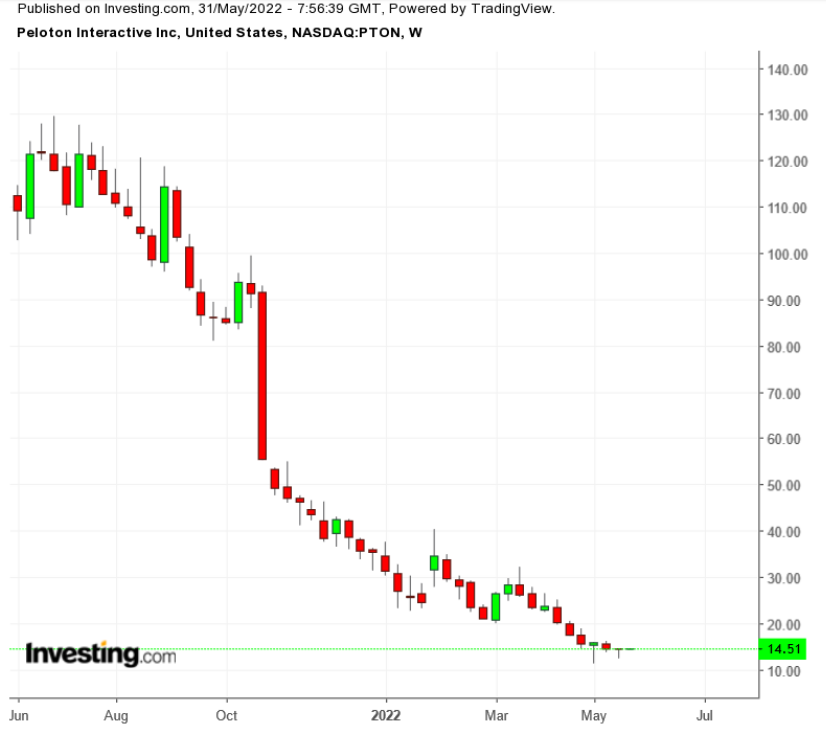This article was written exclusively for Investing.com
As the COVID outbreak begins to take a back seat to other market worries, the “pandemic winners” have become pandemic losers, shares of Peloton Interactive (NASDAQ:PTON) have been perhaps the biggest of those losers. In January 2021, PTON hit an all-time high just above $163; it closed Friday below $15.

That kind of decline, on its own, seems to make Peloton stock at least intriguing. Obviously, to some degree, the market overreacted in bidding the stock up early last year. After a 91% decline, it would seem at least possible that the market is doing the same in selling the stock off.
It certainly is possible. But it's far from guaranteed. Just because PTON is down big doesn't mean it's cheap. It certainly doesn't mean it's cheap enough.
Ugly Fundamentals
It bears repeating: where PTON traded in early 2021 is almost completely immaterial to where it will trade in 2023. Even a cursory look at the fundamentals here highlighted the risk.
Peloton still has a market capitalization near $5 billion. (Yes, the company was valued at almost $50 billion 16 months ago. To put that into context, packaged foods giant Kraft Heinz (NASDAQ:KHC) currently has a market cap of just $46 billion.) Even looking at results from fiscal 2021 (ending June), Peloton's best year, that figure doesn't look exactly cheap.
In FY21, Peloton generated $4 billion in revenue. A 1.25x price-to-sales multiple might sound cheap—but Peloton isn't a software company. Its gross margins this year should be about 25%; at that level, Peloton is trading at 5x peak gross profit.
That's not inexpensive. Nor is a 19x multiple to FY21 Adjusted EBITDA (earnings before interest, taxes, depreciation and amortization). Free cash flow figures are even worse: Peloton generated $223 million in FY20, but incredibly has burned almost $2.4 billion over the past seven quarters.
Three Lessons
Thus, the fundamentals here tell us three things. First, last year, the market completely misread the situation. It was pricing Peloton as if it would keep growing going forward. In fact, the company's guidance for the fiscal fourth quarter suggests Adjusted EBITDA will be negative $800 million this year—amazingly, more than $1 billion worse than the year before.
Second, even down 90% PTON stock still is pricing in growth, not from where the business is now but from where it peaked. From Q4 FY20 to Q3 FY21 (in other words, the first year of the pandemic), Peloton generated $440 million in Adjusted EBITDA. The current market cap is about 11x that figure.
And given that Peloton itself is projecting a turnaround that will take at least two years, investors can only pay 11x if they believe that, at some point, Peloton's profits and free cash flow will reach new highs.
Third, right now, there's no evidence that Peloton is getting anywhere close to past peaks. Again, the company is burning huge amounts of cash at the moment. And that's because the business is headed in the wrong direction. Revenue year-to-date is down about 3%. More worrisome, gross profit has declined 39%.
In other words, performance has to get better—a lot better—for Peloton stock even to stabilize.
How Does This Get Fixed?
And there are reasons to believe that simply won't happen. In August 2021, with pandemic-driven demand waning, Peloton cut the price of its flagship bike. Amid inflationary pressures, in January, the company reversed course (in the US, by reinstating its delivery fee).
That held for three months, before the company changed tack again. As part of a strategy championed by new chief executive officer Barry McCarthy, Peloton is lowering the price of its equipment in a bid to sell more bikes and drive more subscriptions (which, as part of the same policy, will be more expensive going forward).
But there's a big problem with that strategy: Peloton already isn't making any money off its actual equipment. For the first three quarters of this year, what the company calls Connected Fitness Products posted a gross margin of just $44 million, or 2.3% of revenue. Over the same period, Peloton spent over $800 million on marketing.
Obviously, demand at the moment is somewhat suppressed by the sheer number of bikes sold during the worst of the pandemic. But over the last three quarters, about half the time Peloton was selling its bikes at a higher price than it is now—and it still couldn't make any money.
The reason Peloton stock soared so high last year was that investors believed Peloton could make money off its bikes and make money off its subscriptions. What the recent price cut—coming at a time when input costs are soaring—shows is that even the company's management doesn't believe that's how this will work.
Going forward, it seems highly likely that Peloton is going to be reliant on its subscription revenue for its profit. The company generated just $327 million in such revenue over the first nine months of the fiscal year. Again, its market cap is nearly $5 billion.
The Case for Peloton Stock
All that said, Peloton can't be written off just yet. There still are reasons to be bullish when taking the long view.
After all, there is a real business here—and a growing base of satisfied customers. At the end of fiscal 2017, Peloton had 108,000 paying subscribers. When it went public in 2019 that number had increased and now that figure is nearly 3 million.
Obviously, the pandemic drove some of that growth. But Peloton, impressively, has kept the customers it acquired. Churn, or the number of subscribers who cancel, remains below 1% monthly (net of returning customers). As a result, even with lower bike sales, the subscriber base still is growing.
Peloton believes it has plenty of growth ahead. McCarthy said after fiscal Q3 that he was targeting membership of 100 million—up from a current 7 million. New products and new geographies both can help Peloton move toward that target. And with subscription gross margins above 60%, subscriber growth at some point can get Peloton back to profitability.
There's even some good news on the balance sheet. A key reason why Peloton has burned so much cash of late is that it built a massive amount of inventory. But, over time, Peloton should be able to sell that inventory—about $1.4 billion in finished products at the end of the most recent quarter.
That should improve the balance sheet. Combined with a $750 million debt raise this month, Peloton has the capital and the time needed to attempt its turnaround.
Bottom line: The problem is that capital and time aren't compelling enough reasons to buy Peloton stock, even down 90%. Peloton still has a $5 billion valuation— along with a lot of work left to do. One of those two things needs to change before PTON stock looks truly cheap.
Disclosure: As of this writing, Vince Martin has no positions in any securities mentioned.
***
The current market situation makes it harder than ever to make the right decisions. Think about the challenges:
- Inflation
- Geopolitical turmoil
- Disruptive technologies
- Interest rate hikes
To handle them, you need good data, effective tools to sort through the data, and insights into what it all means. You need to take emotion out of investing and focus on the fundamentals.
For that, there’s InvestingPro+, with all the professional data and tools you need to make better investing decisions. Learn More »
